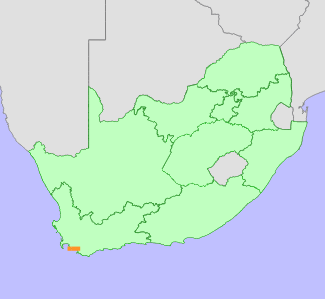|
Scientific Name | Serruria heterophylla Meisn. |
Higher Classification | Dicotyledons |
Family | PROTEACEAE |
Synonyms | Serruria aemula Salisb. ex Knight var. heterophylla (Meisn.) Hutch. |
Common Names | Spindly Spiderhead (e) |
National Status |
Status and Criteria | Endangered B1ab(ii,iii,v)+2ab(ii,iii,v) |
Assessment Date | 2020/04/14 |
Assessor(s) | A.G. Rebelo, H. Mtshali & L. von Staden |
Justification | Serruria heterophylla is a range-restricted species, with an extent of occurrence (EOO) of 103 km², and an area of occupancy (AOO) of 64-68 km². It is known from between three and five locations that continue to decline due to habitat loss and competition from alien invasive plants. It therefore qualifies for listing as Endangered under criterion B. |
Distribution |
Endemism | South African endemic |
Provincial distribution | Western Cape |
Range | This species is endemic to the Western Cape Province of South Africa, where it occurs from Kleinmond to the Kleinrivier Mountains. |
Habitat and Ecology |
Major system | Terrestrial |
Major habitats | Overberg Sandstone Fynbos, Kogelberg Sandstone Fynbos, Western Coastal Shale Band Vegetation |
Description | It is associated with shale bands and sandstone soils, and occurs at an altitude of 30-450 m. It is a long-lived species, and survives fires by resprouting from an underground rootstock. Seeds are released after ripening, and dispersed by ants to their underground nests, where they are protected from predation and fire. It is pollinated by insects. |
Threats |
| At least 5% of this species' habitat is irreversibly modified, predominantly due to habitat loss to coastal development and agricultural expansion. There is a slow ongoing conversion of habitat, but the more concerning threat is the infestation of its habitat by alien invasive plants that outcompete this species once alien stands become dense. |
Population |
This is a highly social species known from 20 subpopulations that occur at between three and five locations, along a 30 km coastal stretch. A continuing decline is inferred from dense alien invasive plant infestations in parts of its range. Over most of its habitat, alien plant densities are still low, but if these are not controlled, they are likely to outcompete this species in the near future.
|
Population trend | Decreasing |
Conservation |
| It is conserved at Kleinmond and Fernkloof nature reserves. |
Notes |
| Only resprouters were considered in typifying this species. Other single-stemmed specimens with much reduced terminal leaves and broad, flanged involucral bracts were assigned to the lowland form of Serruria phylicoides. However, resprouting cannot be assessed on most herbarium specimens and the status of this species, as currently defined by its large involucral bracts from herbarium specimens, does not match resprouting in the field. This taxon needs to be taxonomically re-delimited. Broad, flanged involucral bract specimens - assigned to S. phylicoides, occur on Shaw’s Mountain and the southern slopes of the Riviersonderend around Greyton. They should be investigated as to their taxonomical status. |
Assessment History |
Taxon assessed |
Status and Criteria |
Citation/Red List version | | Serruria heterophylla Meisn. | EN B1ab(ii,iii,v)+2ab(ii,iii,v) | Raimondo et al. (2009) | |
Bibliography |
Goldblatt, P. and Manning, J.C. 2000. Cape Plants: A conspectus of the Cape Flora of South Africa. Strelitzia 9. National Botanical Institute, Cape Town.
Manning, J.C. and Goldblatt, P. 2012. Plants of the Greater Cape Floristic Region 1: The Core Cape Flora. Strelitzia 29. South African National Biodiversity Institute, Pretoria.
Raimondo, D., von Staden, L., Foden, W., Victor, J.E., Helme, N.A., Turner, R.C., Kamundi, D.A. and Manyama, P.A. 2009. Red List of South African Plants. Strelitzia 25. South African National Biodiversity Institute, Pretoria.
Rebelo, T. 2001. Sasol Proteas: A field guide to the proteas of southern Africa. (2nd ed.). Fernwood Press, Vlaeberg, Cape Town.
|
Citation |
| Rebelo, A.G., Mtshali, H. & von Staden, L. 2020. Serruria heterophylla Meisn. National Assessment: Red List of South African Plants version . Accessed on 2025/04/14 |
 Comment on this assessment
Comment on this assessment

